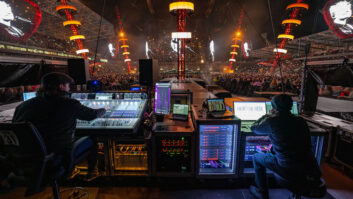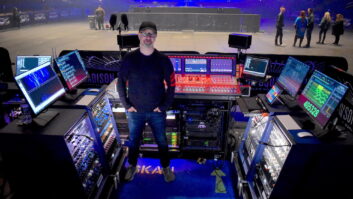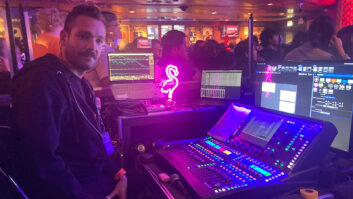Capping a whirlwind tour of North America in support of his sixth album, Speak of the Devil, Chris Isaak recently sold out two nights at San Francisco’s Warfield Theatre. Stepping onstage like a casino cowboy in a lavender velvet suit adorned with sequins, Isaak earned the devotion of his fans before crooning a single song. Later in the show, he changed to a mirror-covered outfit that transformed him into a brilliant bundle of beams. In light of Isaak’s numerous film and TV appearances, it’s somehow appropriate that the sound system is provided by Hollywood’s A-1 Audio and that both engineers hail from Las Vegas.
Kevin Harvey, whose recent engineering credits include Collective Soul and Foreigner, mixes Isaak and perennial backup band Silvertone on a Yamaha PM4000. FOH effects include a Roland SDE-330 delay, TC Electronic M5000, Yamaha SPX900 and SPX1000, plus a Lexicon PCM 70 that’s used on acoustic guitar and keyboard solos. The M5000 is Harvey’s main vocal reverb, and he uses both machines, mixing two different scenes on adjacent stereo faders. Harvey also uses both SPXs on drums, with the 900 generally on short plates and the 1000 on long halls, “balancing and blending the two effects on snare and toms,” he explains. “It’s something I’ve done for a long time, and I’ll use more of the long reverb depending on the sound of the room.” Harvey controls his effects with a Yamaha MPC-1 MIDI controller.
Inserts include a BSS DPR-402 on the acoustic guitars and Drawmer gates on the drum inputs. Kick, bass, keys, backing vocals and the Leslie high rotor get dbx 160x compressors, while a dbx 165 is used on the Leslie low rotor. Isaak’s vocal and spare mics run through a Summit DCL-200, along with a BSS DPR-901 dynamic equalizer and a KT DN410 parametric equalizer. The effects rack also includes a Wendel Jr. sampler, which Harvey uses to add texture on slower songs. The unit is triggered by a pre-fade feed from the kick-drum channel via another dbx 160x.
The main speaker system consists of EAW KF850s, which are flown in typical double-column theater arrays and powered by Crest 8001 amps. The SB850 subwoofers are deck-stacked along with a single KF850, plus a pair of JF260s on each side as front-fills. Harvey equalizes the system with three Klark-Teknik 3600 programmable graphics and uses a pair of BSS 804s to delay the front-fills and flown speakers by a few feet so that Isaak gets a good feel in the center of the stage. Like all good audio teams, Harvey and monitor engineer Connie Fernstrom work together on the combined response of the lead vocal mic in the mains and monitors, along with its interaction with the hall. A-1’s Ryan Trefethen, who was out with Jane’s Addiction last year, rounds out the three-person audio crew.
Monitor chores are performed by Fernstrom on a Yamaha PM4000M and a rack of Klark-Teknik graphics. Isaak relies on a pair of personal single-15 tri-amped Compact Monitor Systems wedges, powered by a BGW amplifier. The other proprietary JBL-loaded floor monitors are powered with Crest 7001 amps. A Tasco XT double-15 sits on the drum riser, and the remaining bandmembers listen to A-1’s DFM single-12 slants, with a stereo pair at the keyboards. KF850 sidefills sit on the floor at the downstage corners and are angled up with audio logs.
Fernstrom also provides in-ear mixes via a rack of Radio Station transmitters. Isaak listens to UE-5 two-way custom molds, while bandmembers use a single Sony ear-bud for turbo-charged monitoring that combines with their wedges. “Initially, we went to just the in-ears, and it was too sterile,” Fernstrom explains. “Chris is really happy with the Ultimate Ears.” Isaak’s in-ear mix is mainly his voice and guitar, kick and snare, plus a few vocal or keyboard cues, with ambience mics between songs. Reaching over each sidefill cabinet is a Shure Beta 87 on a boom-stand, aimed toward the audience but also positioned to catch some of the stage.
“I split the snare to two inputs, with one for the wedges and the other for Chris’ ears,” Fernstrom continues. The wedges get a big, fat sound, while Isaak is also listening for the subtleties from brush work and side-stick. Inserts include KT 514 gates on drums and 160x on bass and vocals. “I’m compressing the vocals to smooth them out because of the ear mixes,” Fernstrom says. “Chris’ range goes from singing softly to a full-voice howl.” Fernstrom uses a Yamaha SPX 1000 on vocals and a Lexicon LXP-15 for drums to sweeten up the ear mixes. He has inserted a 160x compressor on the SPX 1000’s input so he doesn’t have to ride it so much.
Silvertone has backed up Isaak his entire career with only minor personnel changes. Veteran Kenny Dale Johnson’s five-piece maple DW kit is miked with an SM57 on snare, SM98s on toms and AKG 414s for overheads. A Sennheiser KM40 is the under-snare mic, and Neumann KM84 condensers are used on the two sets of high-hats. A second “cocktail kit” that Johnson plays downstage for a couple of rambunctious rockabilly songs that close the set is miked with a Beyer M-88 on kick and another 57 on snare.
Roland Sally’s double Bassman rig is miked with an EV RE-20. Guitarist Hershel Yatovitz uses an X-Wire digital wireless for his various Strats and a Guild 12-string acoustic, and his twin Fender Twins are miked with a pair of Sennheiser 409s. Joining Isaak for road shows this year is Brett Tuggle, who plays a Korg Trinity keyboard and a Hammond B-3. The Leslie’s high rotor is miked with a 57; a 421 is used on the lows.
While SM58s are used on backing vocals, Isaak sings into Audio-Technica’s new 4055 vocal condenser mic, the version without the low-frequency roll-off. “It’s flat and full-sounding,” Fernstrom comments. “Chris likes it a lot, and he says it’s almost too clean.” A D-3 Mic Mute proximity gate turns the vocal mic off when Isaak steps away from it, removing the drum bleed from his ear-mix as well as from the mains. Harvey points out that Isaak is a pleasure to work for: “He’s very cooperative to work with as an artist and is always happy to turn down the stage volume to accommodate me.”
Following the obligatory appearance of material from the new album and Isaak’s signature hit, “Wicked Games,” members of the audience eagerly accepted Isaak’s invitation to the front of the stage for a dance party of up-beat tunes spanning his career, and some eventually joined him onstage. By the time he played “San Francisco Days” in the second encore, it was obvious that Chris Isaak was back in the saddle.







